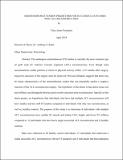Semitendinosus Tendon Predictors for Successful Outcomes Post-ACL Reconstruction
Author
Amat Fernandez, Clara
Abstract
The autologous semitendinosus (ST) tendon is currently the most common type of graft used for Anterior Cruciate Ligament (ACL) reconstructions. Even though most reconstructions enable patients to return to physical activity within ~6-9 months after surgery, long-term outcomes of the surgery must be improved. Previous literature suggests that there may be innate characteristics of the semitendinosus tendon that can potentially predict a negative outcome of the ACL reconstruction surgery. The hypothesis of this thesis is that donor tissue size and stiffness can distinguish between good or poor outcomes post-reconstruction. Specific to this thesis project, we hypothesize that individuals who have had multiple ACL reconstructions will have smaller and less stiff ST tendons compared to individuals with only one reconstruction, as well as, healthy controls. The purpose of this study is to determine if individuals with multiple ACL reconstructions have smaller ST muscle and tendon CSA, length, and lower ST stiffness compared to: 1) individuals who have had a single successful ACL reconstruction and 2) healthy controls. Data were collected on 20 healthy control individuals, 12 individuals that underwent a single successful ACL reconstruction with an ST autograft, and 4 individuals that had undergone multiple ACL reconstructions with at least one with an ST graft. Tendon cross- sectional area (CSA), length, and stiffness were measured using ultrasound (US) and shear wave elastography (SWE). In addition, all participants took the Tegner survey to assess sport- and activity-specific knee demands and all ACL reconstructed participants took the KOOS and Hamstring surveys to have an overall impression of their perceived function. One-way ANOVAs were used to assess differences across the three subject groups for ultrasound-based variables and the surveys scores. Moreover, a correlational analysis associating the KOOS scores to the US-based variables of the injured limb was also assessed. The uninvolved limb of the ACL reconstructed was used as a surrogate of their injured leg prior to ACL reconstruction. The matched limbs of the healthy controls were not statistically different to the uninvolved limbs of the reconstructed individuals in any of the US-based variables or SWE. However, within the reconstructed subjects, ST tendon stiffness of the reconstructed limb was associated with the Quality of Life subscore of the KOOS survey (r=0.561, p=0.024). The current thesis had several limitations that could have masked the results obtained: 1) the multiple reconstructed group had a small sample size, 2) the range of time since harvest was highly variable between groups and within individuals of the same groups, 3) it is possible that the US cannot differentiate between good and poor outcomes when using the uninvolved limb as the surrogate and 4) the definition for positive vs. poor outcomes solely based on the number of reconstructions did not take into account other factors that play a large role in determining positive outcomes from ACL reconstruction. Because the harvested ST tendon stiffness does not return to normal levels and because it is positively associated with knee quality of life, stiffness should be further studied in order to know the extent of its role in determining knee joint function post ACL reconstruction.
Subject
Date
2018-05-02
Citation:
APA:
Amat Fernandez, Clara.
(May 2018).
Semitendinosus Tendon Predictors for Successful Outcomes Post-ACL Reconstruction
(Master's Thesis, East Carolina University). Retrieved from the Scholarship.
(http://hdl.handle.net/10342/6751.)
MLA:
Amat Fernandez, Clara.
Semitendinosus Tendon Predictors for Successful Outcomes Post-ACL Reconstruction.
Master's Thesis. East Carolina University,
May 2018. The Scholarship.
http://hdl.handle.net/10342/6751.
May 10, 2024.
Chicago:
Amat Fernandez, Clara,
“Semitendinosus Tendon Predictors for Successful Outcomes Post-ACL Reconstruction”
(Master's Thesis., East Carolina University,
May 2018).
AMA:
Amat Fernandez, Clara.
Semitendinosus Tendon Predictors for Successful Outcomes Post-ACL Reconstruction
[Master's Thesis]. Greenville, NC: East Carolina University;
May 2018.
Collections
Publisher
East Carolina University

